All companies tend to nurture collaboration — but, not all companies have a collaborative culture.
This sounds like a logic puzzle or a quote from the famous Tolstoy’s book, but it’s not.
It’s just a simple fact.
So what’s the difference between collaboration and a collaborative culture?
The answer to this question (and many others) lies in the following paragraphs.
In this blog post, first, we’ll see what collaborative culture in the workplace is.
Then, we’ll consider its benefits and the most significant components.
In the end, we’ll give you a few tips that will help you create and maintain a collaborative culture at work.

Table of Contents
What is a collaborative culture in the workplace?
Collaborative culture is one where collaboration is deliberate and regular. It occurs in companies that nurture collaboration strategically, on a daily basis.
It’s not enough to initiate collaboration now and then. You have to incorporate it into everyday processes and employees’ attitudes.
For that, you need a strategy — we will explain these strategies later.
First, let’s consider why a collaborative culture is significant.
What are the benefits of a collaborative culture?
If you’re still wondering whether you should strive towards a collaborative culture in your workplace, we have a few reasons to nudge you towards it.
We even called for an expert backup, so we’re offering you their opinions as well.
Without further ado, let’s look at the benefits of a collaborative culture.
✓ Collaborative culture creates innovations
When working in a company that fosters a collaborative culture, employees feel they’re an integral part of the community.
When they feel like an integral part of the community, employees feel more comfortable to think outside the box and come up with innovative ideas.
An experienced HR leader, business consultant, and the owner of Patterson Consulting Group, Jennifer Patterson, weighs in on the subject:

“When business leaders foster collaborative cultures, they open their companies to the potential of new joint initiatives. By encouraging cooperative work structures and supportive atmospheres, companies can create a culture that increases the flow of information and ideas throughout the entire organization.”
Another expert we consulted, Sherryanne Meyer, a corporate communications director at Rizing, agrees with Patterson:

“Workplaces that design and nurture a collaborative culture benefit from a greater flow of ideas, which leads to innovation, a sense of belonging, which supports diversity and inclusion, and increased productivity as silos dissolve and processes are streamlined.”
✓ Collaborative culture improves employee engagement
According to a recent study, 84% of employees aren’t fully engaged at work.
If we take into consideration the fact that engaged employees are more likely to contribute to the company’s success, we shouldn’t take this lack of engagement lightly.
On the other hand, employees that collaborate are more engaged and satisfied with their work, because they have a sense of belonging to a community or a team.
This directly affects retention rates in the company — and might even be the cure for the infamous Great Resignation.
💡 Pumble Pro Tip
If you’re interested in employee engagement and want to find out more about it, check out our blog post:
✓ Collaborative culture helps in talent recruitment
After the Great Resignation came the Great Reshuffle — at least according to LinkedIn’s research Global Talent Trends 2022.
In other words, employers and employees are rethinking the old ways of working.
This research also states that the era of human-focused company culture has begun — which also means that collaborative culture is still a force to be reckoned with.
A part of this collaborative culture is so-called collaborative hiring, the term coined by Steve Jobs himself.
Collaborative hiring involves collaboration between HR and other departments relevant to the hiring process.
In other words, various departments are doing interviews with potential candidates to choose the best fit for the team.
So, the best way to get to the top talent is through collaboration.
✓ Collaborative culture drives performance
According to one Stanford study, employees who acted collaboratively persisted 64% longer on a challenging task than those who weren’t so collaborative.
In that way, a collaborative culture in a company can significantly improve performance and productivity.
Another study showed that companies that promote collaborative culture were five times more likely to be high-performing.
These stats are not bad! They just say that it pays (literally) to nurture a collaborative culture at work.
For Jennifer Patterson, collaborative culture is essential for encouraging a workforce:

“Fostering collaborative culture within your company can grow the collective efforts of employees. By encouraging this culture shift, managers are helping to create employees who are more productive, collaborative individuals. These employees tend to have a stronger work ethic and a better attitude towards their work.”
—
Since we’ve seen the importance of creating and maintaining a collaborative culture at work, let’s briefly look at its most significant components.
What are the most significant components of a successful collaborative culture?
To achieve a collaborative culture in the workplace, instead of practicing collaboration randomly and sparingly, you need to know the main elements of a successful collaborative culture.
After you get to know these elements, it will be easier for you to incorporate them into your work culture. These are:
- Transparency and knowledge sharing
- Trust-filled relationships
- Leaders who model collaboration
So, let’s begin!
Transparency and knowledge sharing
Firstly and not surprisingly, transparent communication is key to creating a collaborative culture at work, because it’s the main factor contributing to employee happiness, as seen in this study.
Namely, happy and engaged employees collaborate more readily and freely.
Furthermore, cross-team transparency helps you fight another enemy of collaboration — team silos.
Undoubtedly, the easiest way to achieve transparency is using a single communication channel.
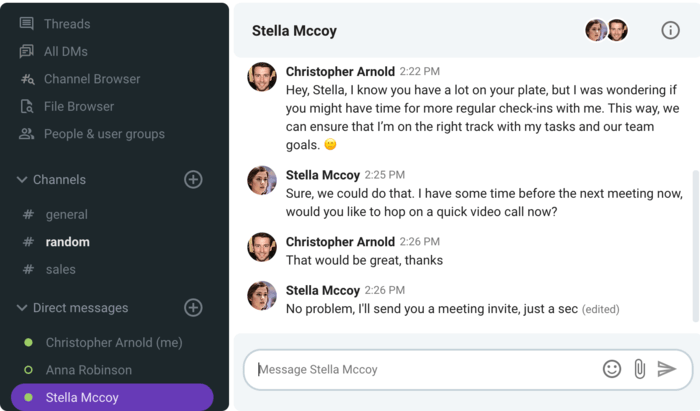
Moreover, open knowledge sharing is a healthy alternative to grapevine communication — another enemy of a collaborative culture.
Trust-filled relationships
Relationships among employees are one of the main prerequisites for a successful collaborative culture.
Don’t worry, there are ways to make these relationships trust-filled. You’ll find them in our section with tips.
Leaders who model collaboration
Another significant component of a successful collaborative culture at work boils down to the following: practice what you preach.
Your role as a leader is to show with your example how your employees should behave.
In that light, strive to show respect to your employees and empower them to collaborate.
If you want to create a collaborative culture at work, make sure you reward teamwork.
Actions speak louder than words — cheesy but true.
—
Now that we’ve learned what the most significant elements of a collaborative culture at work are, let’s consider the best ways to create and maintain such a culture.
What are the best ways to foster a culture of collaboration in the workplace?
By now, we’ve surely intrigued you enough to make you want to dip your toes into a collaborative culture in your workplace.
But, sporadic collaboration doesn’t cut the mustard.
You need a plan — so we’re giving you some tips for achieving this coveted ideal.
Here come ten tips for fostering a culture of collaboration in your workplace.
1️⃣ Provide your employees with collaborative spaces
What does space have to do with making friends or collaborating?
More than you’d guess!
Do you remember how you met your best friend? I’m sure you do, as do I.
It was the first week of college, and I was waiting for a lecture to begin.
By pure coincidence, I was standing next to my little-did-I-know-soon-to-be best friend. We struck up a conversation about who knows what. Cue 20 years later, we’re still best friends.
Now, I’m not saying that you should necessarily find your best friend in your workplace, but the space itself has a big role in bonding with people.
For starters, it enables unplanned collaboration.
What is that, you ask?
Namely, after World War II, psychologists Leon Festinger and Stanley Schachter, and sociologist Kurt Back came to an interesting insight.
Contrary to previous beliefs, similar attitudes and interests weren’t the key factors in making friends.
These scientists realized that people who passed each other often during the day became friends and developed similar attitudes.
Their thinking influenced Steve Jobs and Google’s Sergey Brin and Larry Page, who realized they could use this insight to encourage chance meetings and unplanned collaboration.
So, they designed their workspaces with the central atrium, so that people could mingle with coworkers they might otherwise not meet.
2️⃣ Prioritize relationships and collaboration
Do you have a best friend at work?
According to Gallup’s research, women who have a best friend at work are more likely to be engaged at work — 63% of them — as opposed to the women who don’t have a work best friend (only 29% of them are engaged).
The science is clear — employees are more motivated and productive when they form a strong bond with their coworkers.
This, in turn, leads to better collaboration and gets you one step closer to a collaborative culture at work.
We’ve already mentioned that space plays an important role in forming friendships, so use it wisely.
Provide your employees with a place they can hang out in, maybe with a foosball or a pool table.
Give your employees opportunities to get to know one another, bond, and maybe come to an unplanned collaboration.
Even if you don’t see the results immediately, never mind. You’ll still have a pleasant work atmosphere, and that’s what counts.
3️⃣ Find the right tools
Whether working in the office or remotely, you need great software that will bring the team together.
According to research, almost 80% of employees are using collaboration tools. Before the pandemic, this percentage was just above half.
That’s why it’s paramount that you choose the right software for collaboration among the team members.
For instance, the business messaging platform Pumble allows you to create user groups, different channels, and add team members. This streamlines your communication and facilitates collaboration.
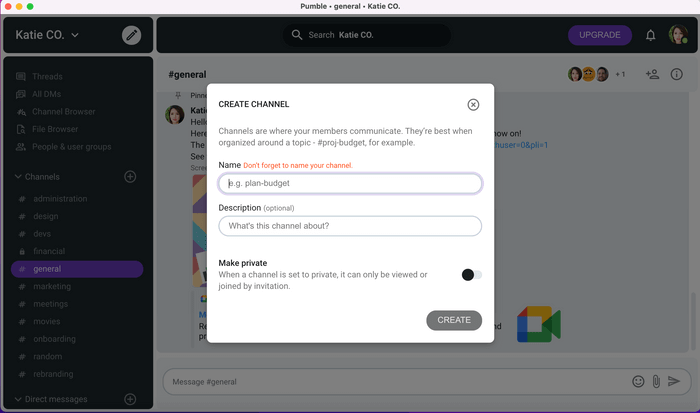
4️⃣ Develop collaboration strategies
No matter how good, tools are not enough.
For trust-filled relationships among your employees, you need strategies for collaboration.
However, there is no one-size-fits-all approach. You have to check the pulse of your team and find out what suits you best.
Another expert we reached out to while researching this topic was Dr. Deb Mashek, who is currently writing a book with the same subject matter.
She told us:

“Whatever your reason for wanting to collaborate is, make the decision TO collaborate just that: a decision. Don’t mindlessly slide into collaboration.
Collaboration brings with it real costs, as well as incredible benefits. Be mindful and deliberate about saying yes to this important relationship. And then: do the hard work to back up your commitment.”
Only then can you achieve outstanding results.
💡 Pumble Pro Tip
If you want to find out more about strategies for effective team collaboration, check out our in-depth piece about it:
5️⃣ Foster a mindset of servant leadership
When a leader’s primary goal is to provide service to their people, we’re talking about servant leadership.
A servant leader makes sure that his employees are advancing in all areas, professionally and personally.
Since a servant leader focuses on his subordinates, his or her main role is to communicate with them and listen to their needs.
Having that in mind, servant leaders should be:
- Good listeners,
- Empathic,
- Aware of themselves and their employees, and
- Persuasive, without being forceful.
Such a mindset will help them create and maintain a collaborative culture in which every voice is heard and acknowledged.
6️⃣ Clearly identify roles and responsibilities
To nurture a truly collaborative culture at work, you need to have a collaboration strategy, with clearly set goals.
Just as well, collaboration should be embraced on all levels in the organization, and everyone’s voice should be heard.
Moreover, everyone in the organization should understand their role in the bigger picture.
Don’t be afraid to overcommunicate — this way, you can avoid any misunderstandings.
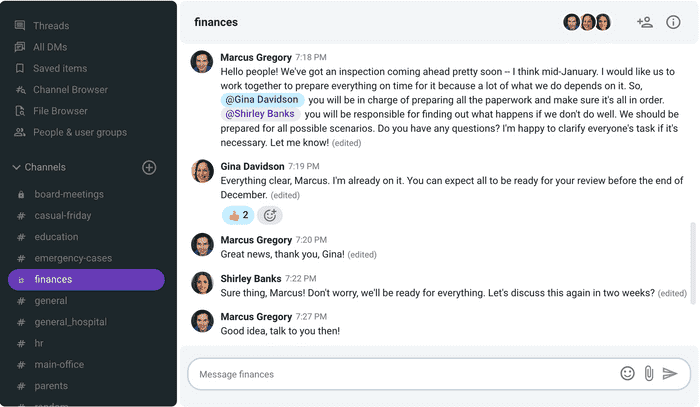
7️⃣ Organize in-person meetings
In-person meetings are important for creating trust-filled relationships, even for those working remotely.
Nothing beats face-to-face meetings.
If you’re working in different time zones, don’t despair.
You can probably organize some sort of a gathering at least once a year, for an anniversary of the company, an inspiring conference, or just a team bonding trip.
If all else fails, you can always count on virtual team bonding activities.
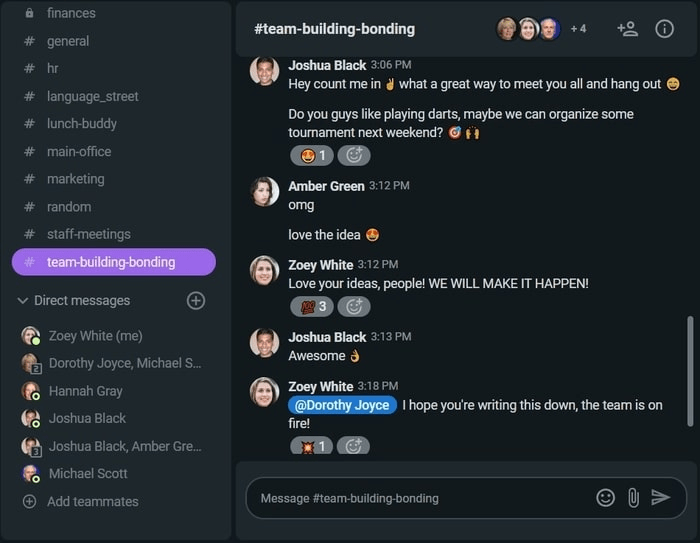
8️⃣ Examine your rewards system
If you want to achieve a collaborative culture, make sure you encourage and reward teams that collaborate, not lone wolves.
By rewarding the teams that show cooperative spirit, you’re demonstrating to the rest of the team where the company’s values lie, thereby stimulating other team members to do the same.
Don’t forget to give public praise to those projects that owe their success to cross-team collaboration.
9️⃣ Encourage feedback
Building a collaborative culture is time-consuming and you should be patient if you want it to last.
One of the things you should work on is encouraging constructive feedback — whether you’re working remotely or in the office.
Remember, this is a two-way street — you should ask for and give feedback.
Only then can you achieve impressive results and create a work atmosphere in which collaboration can flourish.
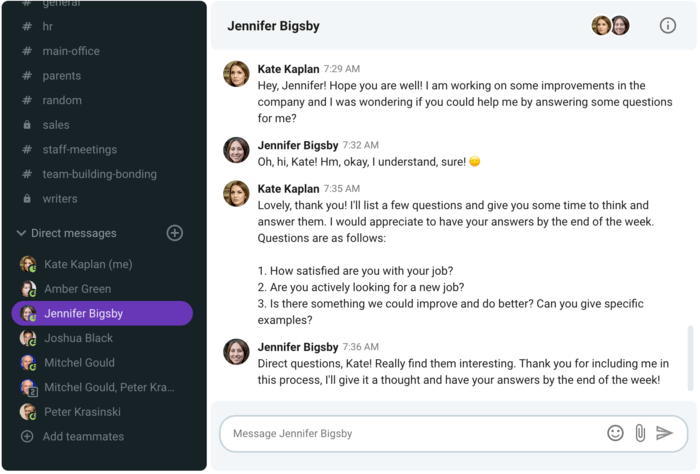
🔟 Lead by example
Last but not least, show your employees how it’s done — don’t just talk the talk, but rather walk the walk.
Highly collaborative companies call for leaders who themselves use and demonstrate collaboration strategies and tools — thereby encouraging their employees to do the same.
Wrapping up: Collaborative culture is your secret to success
It’s not enough to now and then incorporate collaboration into your workflow.
Collaboration should be woven into your workflow so intricately, that you can’t tell it apart from the workflow itself.
We’ve given you 10 tips on how to create and maintain a collaborative culture at your workplace. Try them on and make a leap from sporadic to continuous collaboration, to achieve the ideal — a collaborative culture.




